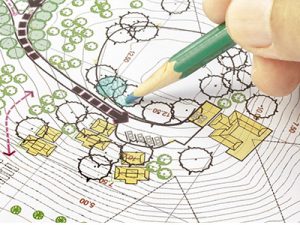Just as in art, architecture, and interior design, perspective and the existence of a focal point are vital considerations in landscape design. Even in nature, the human eye can identify “layers” of different elements that come together to form a total picture. The next time you look at a forest, a beach scene, or pristine natural acreage, you can appreciate this concept by first examining what is visible on the horizon, and then gradually honing in on the land contours and the details of what is visible right in front of you.
Those are the landscape sight lines that influence your perceptions. They can occasionally be chaotic, or they can be calming. In an installed landscape, it’s possible to simulate long views and emphasize close-up details by carefully controlling design details, plants, and landscaping elements to enhance the view, no matter where you look.
Conscious Space Planning
 The North Carolina State Extension Service, in an introduction to landscape design, defines landscaping in the following way: “It is the conscious arrangement of outdoor space to maximize human enjoyment while minimizing the costs and negative environmental impacts.”
The North Carolina State Extension Service, in an introduction to landscape design, defines landscaping in the following way: “It is the conscious arrangement of outdoor space to maximize human enjoyment while minimizing the costs and negative environmental impacts.”
The guide was developed to help homeowners design their own residential landscapes, but the same ideas apply to commercial landscaping. Basic principles are the same; they always involve the integration of buildings and other structural elements on the site with plants and open space to create a harmonious whole. Effective landscaping is visually stimulating, and the best landscapes also appeal to other senses with, for instance, the sounds of flowing or splashing water, pleasant floral scents, textural variety, birdsong, and even an occasional “critter.”
A commercial landscape might be characterized by multiple activity areas and uses, but properly-used landscape sight lines will contribute to the cohesiveness and functionality of the total space, no matter what its size or function.
Landscape Sight Lines and Maximizing their Impact
Commendable landscapes add value, encourage appreciation and enjoyment, enhance intended property use, establish a continuing relationship between the built environment and the site, the neighborhood and the ecosystem, and fulfill human needs. But rarely is a garden or landscaped public area enjoyed from only a single vantage point.
Even if a garden is designed on a central axis with a single focal point, there will be a variety of views, often both from a building interior as well as from various outdoor locations. A professional landscape designer will consider how the experience changes as people navigate through, in and around the landscape, and the different perspectives that exist at varying heights or under varied lighting conditions.
Well-defined landscape sight lines direct the eye to a specific place or element. The primary sight line might end at a wall or continue to the horizon. Secondary sight lines, within a landscaped area, are also important. Designers utilize such directional sight lines to add to a sense of discovery, or perhaps even to block a less-than-desirable vista. Whether what a person encounters in the landscape is intimate or expansive depends on the mood the designer wants to create. Long views add to an illusion of space and may heighten the sense of arrival when someone reaches the destination, whether that point is a major art installation, a restaurant, or an inviting pool patio.
Creative Use of Landscaping Sight Lines
Direct Traffic
Guide visitors to a specific area within a larger site by the use of a straight-line path with planting areas on either side. If the path leads to a restaurant or public seating area, or if the space is very large, smaller “pause points” along the way can be much-appreciated diversions. Secondary paths can lead to special attractions and unique features in the landscape.
Create Privacy
By limiting long views, the designer can create pleasant oases where people can congregate in small groups. Winding pathways, trimmed hedges, landscaped berms, masonry walls, and elements that include gateways, gazebos, or structures with vining greenery are often-employed as landscape elements.
Introduce a Surprise Element
It might be the courtyard fountain of an outdoor shopping center, the pool and entertainment deck of an apartment complex, or the grounds of a public building that holds a memorial, historical plaque, or commemorative statue. Within the primary landscaped area, specialty planting areas are ideal for quiet contemplation, subsidiary focal points, or dramatic elements.
Frame the View
Use linear features in the landscape to frame the desired view. Plant trees and shrubbery in straight-line patterns or in circular configurations, or keep surrounding shrubbery low to add to the impression of unlimited space. If there’s something wonderful to see at the end of the sight line, consider placing benches or installing low walls so that visitors can fully enjoy the sight.
Look Out, Look Up
Site lines for landscaping purposes don’t always exist in a horizontal plane. Particularly in commercial landscapes, looking up can provide as dramatic a vista as looking straight ahead. Plant tall trees to heighten the effect of soaring space, or highlight an architecturally stunning building by focusing on vertical space from a ground-level perspective.
Specimen plants, unique trees, comfortable seating areas, a dramatic water feature, or public gathering spots are common elements used to add drama to a commercial landscape. However, canopies, tall art, walls of differing heights, and other innovative landscape elements are entirely appropriate.
Benefits of Professional Landscape Design
In order to design and install a landscape that will continue to delight our clients and add value to the property, ASI Landscape Management approaches every landscape plan by considering the architecture of surrounding buildings, site specifics that include actual size, planned use, limitations, and restrictions, required maintenance and upkeep, and budgetary constraints. With more than 20 years of experience meeting the distinctive needs of commercial clients in the areas we serve, we have developed a comprehensive process that allows our team to tailor solutions for all types of landscaping situations.
Throughout the process, we rely on our professional expertise. We understand the unique weather patterns that influence what we install in Tampa versus the plants that are better suited for Orlando landscapes. Because we offer complete landscape maintenance services, including horticulture and arbor care, as well as irrigation installations, we are careful to recommend hardy plants that will thrive where they are planted.
When you require landscaping services of any kind for your Florida commercial site, contact us to schedule a consultation. We’ll focus on your specific needs, and keep our sights trained on the success of your project!


